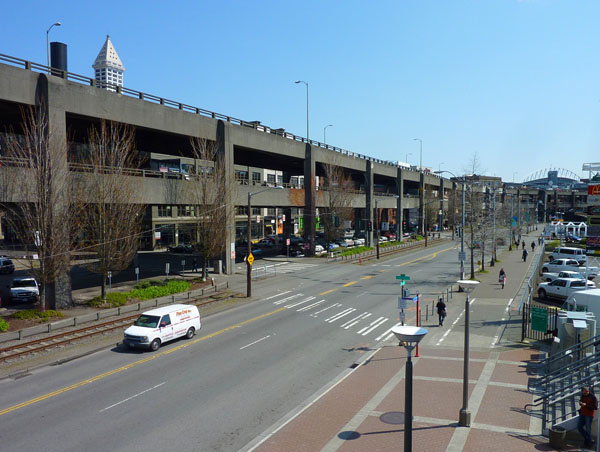What Really Causes Gridlock? Cities Do.
The recently published University of Washington study on the effects of removing Seattle’s Alaskan Way Viaduct on commute times is but the latest data-based rebuttal to claims made by deep-bore tunnel proponents that a surface option would create gridlock.
Comparing a tunnel to a “worst-case scenario in which the viaduct is removed and no measures are taken to increase public transportation or otherwise mitigate the effects,” the UW study predicted a mean increase in commute time of six minutes, and also that “in the rest of the region, on I-5, there’s no indication that it would increase commute times at all.”
And that’s without any of the improvements to I-5, the street grid, and transit service that would be part of an integrated I-5/Surface/Transit alternative.

< Let's Move Forward's pro-tunnel ad trots out the "gridlock" boogeyman >
In recent months tunnel supporters seem to have coalesced on the idea that the “gridlock” meme will resonate with the general public, and they are no doubt correct. The only catch is that the gridlock claim has no basis in fact. No matter though, gridlock is a superb boogeyman, and that’s politics, as the Republicans have taught us well.
But stay with me now, because regarding so-called “gridlock,” here’s a reality that all of us city-boosters need to come to grips with: a dense city without heavy traffic congestion is like a unicorn. That is, it doesn’t exist.
Tunnel or no tunnel, if Seattle densifies to the degree necessary for achieving significant sustainability benefits, all of our key roads are going to become jammed with cars. Road networks have inherent spatial limitations, such that in any urban area with a high density of homes and jobs, the demand for auto trips is guaranteed to swamp the capacity of the roads. It is as close to a mathematical certainty as you’ll ever find in the unpredictable realm of cities.
Once this inevitable end is recognized, the only sane path for moving forward becomes clear: Stop throwing away precious public funds on roads, and instead invest in solutions that give people transportation alternatives. And it just so happens that that path is also one of our most promising strategies to address urban sustainability, and for Seattle, climate change in particular.
Yes Seattle, expect more gridlock in your future (driven on Denny Way on a weekend lately?). It’s coming, whether or not we spend billions on a deep-bore tunnel in a flailing attempt to avoid it.
But that doesn’t mean the downfall of civilization. The solution is to create a city in which people can get around without relying on a car. This includes not only building infrastructure to support walking, biking, and transit, but also creating compact, mixed-use centers that reduce the need for long trips. I have yet to hear a convincing argument for how a 2-mile underground bypass freeway for cars is anything but anathema to that strategy.
It comes down to deciding what a city is for. Is it a place to get through, or a place to be?


